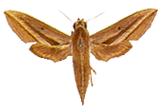|
Theretra oldenlandiae Fabricius
Sphinx oldenlandiae Fabricius, 1775, Syst. Ent., p. 542.
Theretra oldenlandiae Fabricius; Rothschild & Jordan, 1903: 781.
|

Theretra oldenlandiae 
(.83
natural size)
|
Diagnosis. This and Theretra
silhetensis Boisduval are similar in size and coloration,
and both have a conspicuous broad, dark brown band running obliquely
across the forewing from subbasally on the dorsum towards the apex. In
oldenlandiae this band is evenly tapered rather than lenticular, is
directed towards the costa subapically rather than towards the apex, and
is reflected by a similar but narrower band more distally. The dorsal
silver band on the abdomen is double rather than single; there are
stronger subdorsal streaks on the thorax.
Geographical range. Japan, Indo-Australian tropics to Solomons.
Habitat preference. This is another species of open lowland habitats.
Biology. The larva has been described by Bell & Scott (1937), Dupont
& Roepke (1941) and Moulds (1981). It is velvety black, spotted leaden
bluish over the abdominal segments, with a yellow dorsolateral band that
is strongest over the thoracic segments; on these segments there is a
similar ventrolateral band. The ocellar markings break the dorsolateral,
those of A1 and A2 black, ringed with yellow and blue, those of the
remaining abdominal segments oblong, reddish, ringed blue. The long,
straight horn is black, tipped white.
Recorded host-plants (Bell & Scott, 1937; Pholboon, 1965; Miyata,
1983; Moulds, 1981, 1984; CIE records) are: Alocasia, Amorphophallus,
Arisaema, Caladium, Colocasia, Cryptocoryne, Pinellia, Typhonia,
Zantedeschia (Araceae); Impatiens (Balsaminaceae); Careya, Planchonia
(Barringtoniaceae);
Clystostoma (Bignoniaceae); Ipomoea (Convolvulaceae); Hibbertia
(Dilleniaceae);
Clarkia, Epilobium, Fuchsia, Ludwigia (Onagraceae); Coelospermum,
Oldenlandia, Pentas, Richardia (Rubiaceae); Ampelocissus, Ampelopsis,
Cayratia, Cissus, Vitis (Vitidaceae).
<<Back
>>Forward <<Return
to Contents page
|

